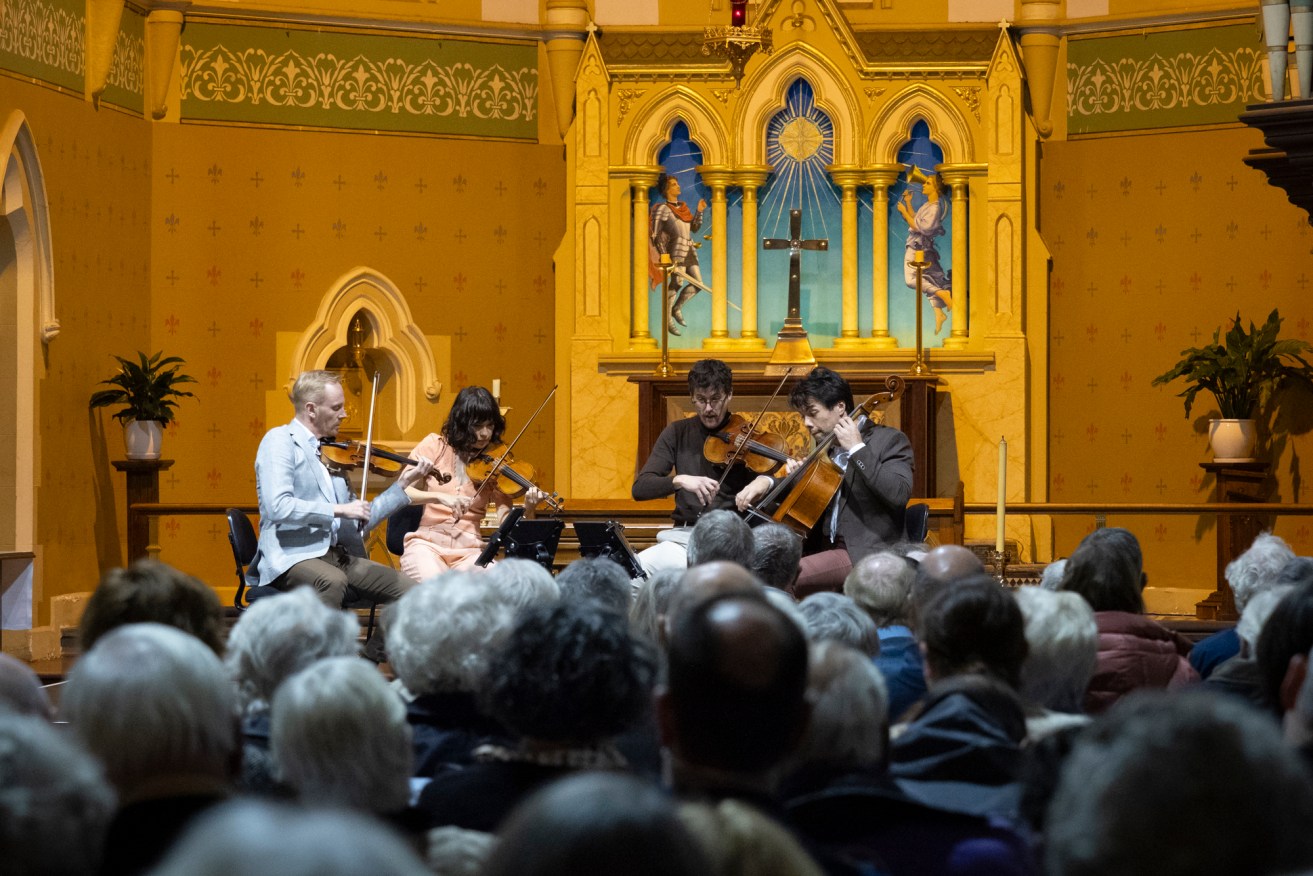Music review: Australian String Quartet’s Florescence
At the end of a long national tour, the Australian String Quartet arrived home in relaxed fashion and served up a most remarkable performance of Haydn. But it was not in their usual venue.


The ASQ at St John's Anglican Church. Photo: Sam Jozeps
It looks like the ASQ might have found itself a new home in the smaller and acoustically nicer St John’s Anglican Church. Bye-bye Adelaide Town Hall – or so it seems for a while.
Despite having to perch oneself on less-than-comfortable wooden pews and the sound of rain pattering of rain on the roof during Dvořák’s String Quartet No.14, it was much more rewarding to hear the group in this much-adored church (especially amongst musicians) on Halifax Street.
Its pristine clarity is so much better and being closer to the players helps the audience connect more with the music.
But the main reason why the ASQ should stay in St John’s from now on became obvious from the start: it lets them play even more wonderfully.
Their high level engagement with the music and sheer love of playing together were never more in evidence than in this concert. Their Haydn, in particular, was flat-out extraordinary and a real ear-opener for any (confessing for myself at least) who admire his string quartets but vex continually over how they can be a bit on the genteel side.
To begin this ‘Florescence’ program, so-named because this word refers to the process of flowering and how each work represented the blossoming of the respective composers at various points in their lives, the ASQ played a lovely new composition by one of their colleagues from Tinalley String Quartet, Justin Williams (some may remember this group’s appearance at Coriole).
His Movement for String Quartet, composed during the COVID lockdowns, is a short but intense and impassioned creation that seems to compress all the string quartet’s expressive possibilities into a single span. This pint-sized piece was thoroughly enjoyable thanks to the beautifully shaped melody, excellent string writing and humour: amusingly, the piece breaks midway into a drunken stagger with lurching violin atop lopsided pizzicato cello.
So fun, and so well played.
It is always interesting how the ASQ tackle ‘standard repertoire’ because they are always striving for something different – whether it’s an enhanced flow or new levels of sonic sheen and precision. With Haydn’s String Quartet in B minor, Op.33 No.1, they reassuringly did not venture too far from established norms so much as discover a whole lot more inside this piece than other players usually seem to realise.
With a flighty but not-too-fast tempo for the first movement, there was no modernist overlay but rather a wonderful deep respect for how each part fits into the whole and how Haydn moves from one extremely characterful state to another with inevitability.
At least in this particular quartet, he is anything but genteel; it was all electrified to almost dangerous touch in this performance. Through its generally cheerful course (itself surprising for a work in a minor key) came unexpected rushes of blood and dashes of pure craziness that might have sabotaged the whole show except for the fact that, paradoxically, Haydn makes them essential to his design.
It was blink-and-you’ll-miss-it though, for the ASQ’s light touch and impeccable finish made his tricks appear and disappear like magic. With a glint in his eye, Dale Barltrop was an absolute genius at achieving this on first violin. Anything fast he dispatched with a wicked sting, especially the last movement’s explosion of furious virtuosity.
Hooray for Haydn: at last a performance of daring. Many distinguished groups just don’t go there, either because they find such moments too embarrassing to deal with or just don’t notice them.
Purcell’s Fantasia No.6 in F Major, meant for viol consort, was taken much too fast, however. It’s a tiny piece by comparison with any actual string quartet repertoire and needs deliberateness to achieve its nobility and purity of sound.
Dvořák’s last and most ambitious work in the genre, his String Quartet No. 14, Op. 105, sure is a mountain to climb. Even with his typical élan, there is a sense of being very nearly overtaken by a complexity verging on the symphonic. Many times the instruments separate into busy counterpoint or combine in massive textures requiring double and triple stops – up to 10 notes at once.
With their characteristic finesse, ASQ are an ideal group to resolve all this; even with them, it got tough-going by the final movement. Many times Barltrop’s lyrical gift came to the rescue by bringing a special coherence and sweetness, and all four players play miraculously tightly and spiritedly together. Yet it comes as no surprise that Dvořák turned to writing symphonic poems and operas after completing this work.
String quartets are in a sense conversation through music, or at least that might serve as a metaphor. Haydn exemplifies this idea perhaps best of all, and his amazing wit and repartee persisted right through this concert; it was interesting to see how much chat and good feeling it sparked amongst concertgoers afterwards.
The ASQ know and understand this. Good on them.
Australian String Quartet played Florescence at St John’s Halifax on August 17.
This article is republished from InReview under a Creative Commons licence. Read the original article.
InReview is an open access, non-profit arts and culture journalism project. Readers can support our work with a donation. Subscribe to InReview’s free weekly newsletter here.
![]()




